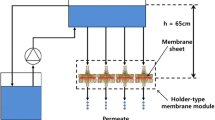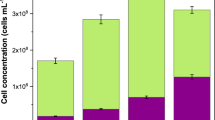Abstract
A pilot-scale gravity-driven membrane (GDM) filtration system under low gravitational pressure without any pre-treatment, backwash, flushing, or chemical cleaning was carried out to investigate the effect of operation parameters (including operation pressure, aeration mode, and intermittent filtration) on the effluent quality and permeability development. The results revealed that GDM system exhibited an efficient performance for the removal of suspended substances and organic compounds. The stabilization of flux occurred and the average values of stable flux were 6.6, 8.1, and 8.6 Lm−2 h−1 for pressures of 65, 120, and 200 mbar, respectively. In contrast, flux stabilization was not observed under continuous and intermittent aeration conditions. However, aeration (especially continuous aeration) was effective to improve flux and alleviate membrane fouling during 1-month operation. Moreover, intermittent filtration would influence the stabilization of permeate flux, resulting in a higher stable flux (ranging from 6 to 13 Lm−2 h−1). The stable flux significantly improved with the increase of intermittent period. Additionally, GDM systems exhibited an efficient recovery of flux after simple physical cleaning and the analyses of resistance reversibility demonstrated that most of the total resistance was hydraulic reversible resistance (50–75 %). Therefore, it is expected that the results of this study can develop strategies to increase membrane permeability and reduce energy consumption in GDM systems for decentralized water supply.







Similar content being viewed by others
References
Akhondi E, Wu B, Sun S, Marxer B, Lim W, Gu J, Liu L, Burkhardt M, McDougald D, Pronk W, Fane AG (2015) Gravity-driven membrane filtration as pretreatment for seawater reverse osmosis: Linking biofouling layer morphology with flux stabilization. Water Res 70:158–173
Boulestreau M, Hoa E, Peter-Verbanets M, Pronk W, Rajagopaul R, Lesjean B (2012) Operation of gravity-driven ultrafiltration prototype for decentralised water supply. Desalin Water Treat 42:125–130
Capodici M, Di Bella G, Di Trapani D, Torregrossa M (2015) Pilot scale experiment with MBR operated in intermittent aeration condition: analysis of biological performance. Bioresour Technol 177:398–405
Cerón-Vivas A, Morgan-Sagastume JM, Noyola A (2012) Intermittent filtration and gas bubbling for fouling reduction in anaerobic membrane bioreactors. J Membr Sci 423–424:136–142
Chang H, Liang H, Qu F, Ma J, Ren N, Li G (2016) Towards a better hydraulic cleaning strategy for ultrafiltration membrane fouling by humic acid: effect of backwash water composition. J Environ Sci 43:177–186
Chen W, Westerhoff P, Leenheer JA, Booksh K (2003) Fluorescence excitation–emission matrix regional integration to quantify spectra for dissolved organic matter. Environ Sci Technol 37:5701–5710
Cheng X, Liang H, Ding A, Qu F, Shao S, Liu B, Wang H, Wu D, Li G (2016) Effects of pre-ozonation on the ultrafiltration of different natural organic matter (NOM) fractions: membrane fouling mitigation, prediction and mechanism. J Membr Sci 505:15–25
Dalmau M, Monclus H, Gabarron S, Rodriguez-Roda I, Comas J (2014) Towards integrated operation of membrane bioreactors: effects of aeration on biological and filtration performance. Bioresour Technol 171:103–12
Derlon N, Peter-Varbanets M, Scheidegger A, Pronk W, Morgenroth E (2012) Predation influences the structure of biofilm developed on ultrafiltration membranes. Water Res 46:3323–3333
Derlon N, Koch N, Eugster B, Posch T, Pernthaler J, Pronk W, Morgenroth E (2013) Activity of metazoa governs biofilm structure formation and enhances permeate flux during Gravity-Driven Membrane (GDM) filtration. Water Res 47:2085–95
Ding A, Qu F, Liang H, Ma J, Han Z, Yu H, Guo S, Li G (2013) A novel integrated vertical membrane bioreactor (IVMBR) for removal of nitrogen from synthetic wastewater/domestic sewage. Chem Eng J 223:908–914
Ding A, Liang H, Qu F, Bai L, Li G, Ngo HH, Guo W (2014) Effect of granular activated carbon addition on the effluent properties and fouling potentials of membrane-coupled expanded granular sludge bed process. Bioresour Technol 171:240–6
Ding A, Pronk W, Qu F, Ma J, Li G, Li K, Liang H (2015) Effect of calcium addition on sludge properties and membrane fouling potential of the membrane-coupled expanded granular sludge bed process. J Membr Sci 489:55–63
Ding A, Liang H, Li G, Derlon N, Szivak I, Morgenroth E, Pronk W (2016) Impact of aeration shear stress on permeate flux and fouling layer properties in a low pressure membrane bioreactor for the treatment of grey water. J Membr Sci 510:382–390
Ferrer O, Casas S, Galvan C, Lucena F, Bosch A, Galofre B, Mesa J, Jofre J, Bernat X (2015) Direct ultrafiltration performance and membrane integrity monitoring by microbiological analysis. Water Res 83:121–31
Gibert O, Lefèvre B, Teuler A, Bernat X, Tobella J (2015) Distribution of dissolved organic matter fractions along several stages of a drinking water treatment plant. J Water Process Eng 6:64–71
He XS, Xi BD, Li X, Pan HW, An D, Bai SG, Li D, Cui DY (2013) Fluorescence excitation-emission matrix spectra coupled with parallel factor and regional integration analysis to characterize organic matter humification. Chemosphere 93:2208–15
Huang H, Spinette R, O’Melia CR (2008) Direct-flow microfiltration of aquasols. I. Impacts of particle stabilities and size. J Membr Sci 314:90–100
Jermann D, Pronk W, Meylan S, Boller M (2007) Interplay of different NOM fouling mechanisms during ultrafiltration for drinking water production. Water Res 41:1713–22
J-y T, Liang H, Nan J, Yang Y-l, S-j Y, G-b L (2009) Submerged membrane bioreactor (sMBR) for the treatment of contaminated raw water. Chem Eng J 148:296–305
J-y T, Xu Y-p, Z-l C, Nan J, G-b L (2010) Air bubbling for alleviating membrane fouling of immersed hollow-fiber membrane for ultrafiltration of river water. Desalination 260:225–230
Kim J, DiGiano FA, Reardon RD (2008) Autopsy of high-pressure membranes to compare effectiveness of MF and UF pretreatment in water reclamation. Water Res 42:697–706
Lee HJ, Laskin A, Laskin J, Nizkorodov SA (2013) Excitation-emission spectra and fluorescence quantum yields for fresh and aged biogenic secondary organic aerosols. Environ Sci Technol 47:5763–70
Li K, Liang H, Qu F, Shao S, Yu H, Han Z-s DX, Li G (2014) Control of natural organic matter fouling of ultrafiltration membrane by adsorption pretreatment: comparison of mesoporous adsorbent resin and powdered activated carbon. J Membr Sci 471:94–102
Liu T, Chen ZL, Yu WZ, You SJ (2011) Characterization of organic membrane foulants in a submerged membrane bioreactor with pre-ozonation using three-dimensional excitation-emission matrix fluorescence spectroscopy. Water Res 45:2111–21
Meng F, Zhang H, Li Y, Zhang X, Yang F, Xiao J (2005) Cake layer morphology in microfiltration of activated sludge wastewater based on fractal analysis. Sep Purif Technol 44:250–257
Meylan S, Hammes F, Traber J, Salhi E, von Gunten U, Pronk W (2007) Permeability of low molecular weight organics through nanofiltration membranes. Water Res 41:3968–76
Miyoshi T, Yamamura H, Morita T, Watanabe Y (2015) Effect of intensive membrane aeration and membrane flux on membrane fouling in submerged membrane bioreactors: reducing specific air demand per permeate (SADp). Sep Purif Technol 148:1–9
Peiris RH, Halle C, Budman H, Moresoli C, Peldszus S, Huck PM, Legge RL (2010) Identifying fouling events in a membrane-based drinking water treatment process using principal component analysis of fluorescence excitation-emission matrices. Water Res 44:185–94
Peter-Varbanets M, Zurbrugg C, Swartz C, Pronk W (2009) Decentralized systems for potable water and the potential of membrane technology. Water Res 43:245–65
Peter-Varbanets M, Hammes F, Vital M, Pronk W (2010) Stabilization of flux during dead-end ultra-low pressure ultrafiltration. Water Res 44:3607–16
Peter-Varbanets M, Margot J, Traber J, Pronk W (2011) Mechanisms of membrane fouling during ultra-low pressure ultrafiltration. J Membr Sci 377:42–53
Peter-Varbanets M, Gujer W, Pronk W (2012) Intermittent operation of ultra-low pressure ultrafiltration for decentralized drinking water treatment. Water Res 46:3272–82
Pronk W, Palmquist H, Biebow M, Boller M (2006) Nanofiltration for the separation of pharmaceuticals from nutrients in source-separated urine. Water Res 40:1405–12
Qu F, Liang H, Zhou J, Nan J, Shao S, Zhang J, Li G (2014) Ultrafiltration membrane fouling caused by extracellular organic matter (EOM) from Microcystis aeruginosa: effects of membrane pore size and surface hydrophobicity. J Membr Sci 449:58–66
Wyart Y, Tamime R, Siozade L, Baudin I, Glucina K, Deumié C, Moulin P (2014) Morphological analysis of flat and hollow fiber membranes by optical and microscopic methods as a function of the fouling. J Membr Sci 472:241–250
Xiao P, Xiao F, Wang D-s, Qin T, He S-p (2012) Investigation of organic foulants behavior on hollow-fiber UF membranes in a drinking water treatment plant. Sep Purif Technol 95:109–117
X-y L, Chu HP (2003) Membrane bioreactor for the drinking water treatment of polluted surface water supplies. Water Res 37:4781–4791
Acknowledgments
This research was jointly supported by the National Science Foundation for the Outstanding Youngster Fund (51522804), Major Science and Technology Program for Water Pollution Control and Treatment (2012ZX07404-003), Science and Technology Program for Public Wellbeing (2013GS370202-003), Science and Technology Planning Project of Chancheng District (2013A1044), and Fundamental Research Funds for the Central Universities. Moreover, the authors are so thankful to Nan Jiang and Dara S.M. Ghasimi (Technische Universiteit Delft) for their help in checking the manuscript.
Author information
Authors and Affiliations
Corresponding author
Additional information
Responsible editor: Angeles Blanco
Rights and permissions
About this article
Cite this article
Tang, X., Ding, A., Qu, F. et al. Effect of operation parameters on the flux stabilization of gravity-driven membrane (GDM) filtration system for decentralized water supply. Environ Sci Pollut Res 23, 16771–16780 (2016). https://doi.org/10.1007/s11356-016-6857-0
Received:
Accepted:
Published:
Issue Date:
DOI: https://doi.org/10.1007/s11356-016-6857-0




